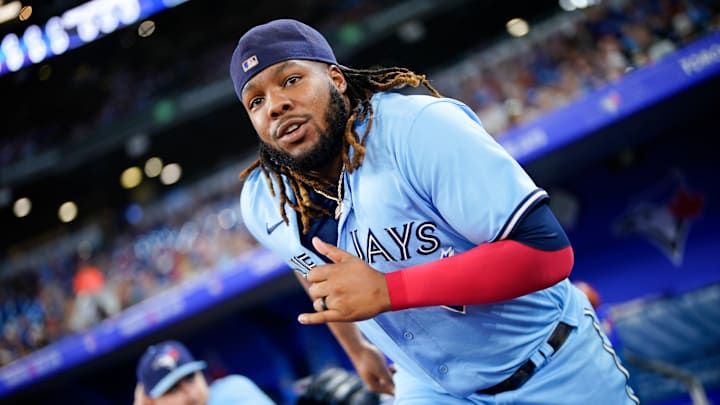Vladimir Guerrero Jr. has put up some MVP numbers this season. Oh wait... That's just his Baseball Savant page. One look under the hood at Vladdy's quality of contact numbers, as illustrated by his statcast and other underlying metrics, and it would be hard to imagine that he isn't blasting his way into another MVP chase this season. But alas, sometimes certain stats don't tell the full story.
Let's have a look at those quality of contact metrics that analytics experts examine to determine what kind of performance to expect from a player.
is Guerrero in the 99th percentile of all major leaguers in Average Exit Velocity (94.7 mph), and 98th in Maximum Exit Velocity (116.7 mph), and in the 99th percentile in Hard Hit percentage (57.3). It certainly seems like he's crushing the ball.
He also has an Expected Slugging Percentage in the 96th percentile, and an Expected Batting Average in the 98th percentile. The numbers are all strikingly similar to what he produced in 2021—a season in which he blasted 48 HR with a .311 average. a .601 slugging and a 1.002 OPS. He finished as the runner-up for MVP that year.
But when we look at the surface stats (and the eye test) from this season, there's a bizarre incongruity. After hitting the game-winning two-run home run in the opener against the Chicago White Sox on Tuesday night, he had just 13 long balls on the season, which leaves him tied for 15th in baseball in that category. His .453 slugging pct. has him tied for 45th overall. And his OPS of .801? Also in the 40s, tied for 48th-best in the majors.
It simply doesn't add up. What gives? Normally, we'd blame the bloated amount of ground balls Guerrero tends to hit; that's been a career-long issue. Killing too many worms. But those GB% numbers are pretty much the same this season (47.4%) as they were in '21 (45.6%), and better than last season, in fact (52.3%).
There are a few other things at play here, however. Vladdy's BABIP (batting average on balls in play)—which is largely a function of luck—is down to .303 this season; but it wasn't extraordinarily high in 2021, when it was .313.
Another factor, which has been a little more significant, is that his ISO — isolated power, which measures the raw power of a hitter by indicating how often a player hits for extra bases—has dropped quite a bit from his near-MVP season, from .290 that year to just .175 this season (for reference, an ISO in the .250s and above is generally considered elite power).
The real difference, it seems, is in the type of fly balls he's been hitting. As pointed out by Nick Ashbourne of Sportsnet, he's hitting such a large amount of his fly balls into the center field area of ballparks, where of course it's much more difficult to leave the yard. In addition, Mike Petriello of MLB.com points out that Vladdy is just not putting the distance on those fly balls that he has in the past. His Home Run to Fly Ball rate (HR/FB) has plummeted from 26.5% in his 2021 season, to 19.9% last year, to just 14.4% this season.
Finally, one more issue that could be affecting Guerrero—and there's just nothing that can be done about this—is his newly-renovated home ballpark. As also noted by Ashbourne, the re-configured Rogers Centre ranks in the bottom-third of parks in baseball in surrendering home runs to right-handed hitters.
In summary, those MVP-like Baseball Savant numbers just aren't translating to real on-field results for Vladdy this season. But it seems like we can stop blaming his groundball rate, and start by looking at the quality, the lift, and the direction of those fly balls.
